 System Tutorial
System Tutorial
 LINUX
LINUX
 The impact of an enterprise's organizational structure on its technical architecture
The impact of an enterprise's organizational structure on its technical architecture
The impact of an enterprise's organizational structure on its technical architecture
| Introduction | Technical personnel often have a tendency to focus on digging coal (working on technical architecture) without understanding the context of coal mining (the business background and organizational structure of the company). They do not know the organizational structure, business background and technology of the company. There is an implicit mapping relationship between architectures, and this relationship sometimes directly determines the success or failure of technical architecture transformation. |
This article attempts to establish this contextual background for technical personnel (especially architects), improve the technical personnel's vision, and allow technical personnel to promote the improvement and upgrading of the system architecture on the premise of understanding the enterprise's business background and organizational structure, with a view to Be more successful.
Economic BackgroundThe picture below is called the bathtub curve, which comes from Niels Pflaeging's book "Organize for Complexity" [Appendix 2]. It mainly reflects the changes in the Western economic model from the last century to the present. The shape looks like a bathtub, hence the name.

- The period before 1900 was called the pre-industrial era, also known as the handicraft era. The main body of value creation in this era was craftsmen who mastered skills. Highly dynamic, localized markets, and customization were the main characteristics of the market in this era.
- The period from 1900 to 1980 is known as the Taylor Industrial Age. The main body of value creation in this era was machines. The market was vast and slow, with little competition. Improving efficiency and competing for low costs through mechanization and large-scale production were the main focus of the market in this era. Features.
- 1980 is now called the post-industrial era, also known as the global economic era. The main body of value creation in this era is knowledge workers. Emerging industries continue to exert competitive pressure on traditional industries. They are highly dynamic and continue to respond quickly to market demand. The key to success in this era of markets.
The organizational structure cannot be simply designed by the leadership. Different economic models require different organizational structure support. There is an implicit mapping relationship between the organizational structure and the economic model.

The picture above is the mainstream Taylor-type organizational structure in the Taylor Industrial Era, also known as the Command & Control organization. The leadership of the organization observes the market and formulates target plans, which are passed down by middle-level managers and implemented by lower-level employees.
The advantages, disadvantages and suitable scenarios of this organizational structure are as follows:
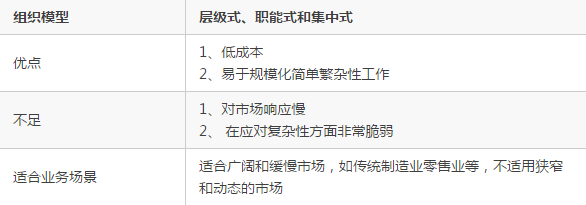
The Taylor Industrial Age lasted for more than a century and had a profound impact on our society. Even today, Taylor-type organizations are still the mainstream organizational structure of various enterprises in our society.
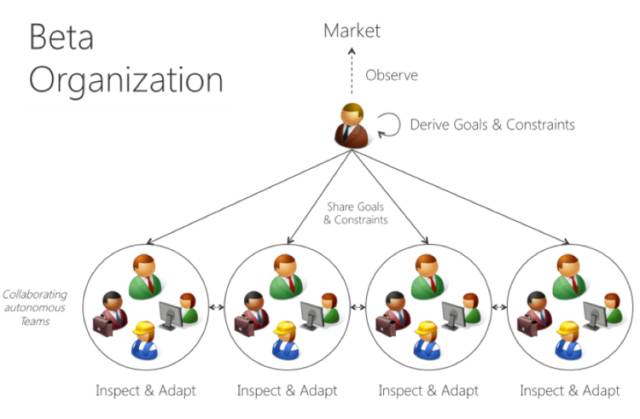
The picture above is a beta-type organization that is gradually emerging in the post-industrial era. It is common in some emerging industries such as mutual benefit network business companies. This type of organization still has leaders who focus on observing the market and formulating shared goals and constraints, but the organizational structure is relatively flat and the team organization favors cross-functional mixing and collaboration to respond quickly to market changes.
The advantages, disadvantages and suitable scenarios of this organizational structure are as follows:

Beta-type organizations are a model of modern leadership models and the direction of learning and transformation for many, especially traditional companies.
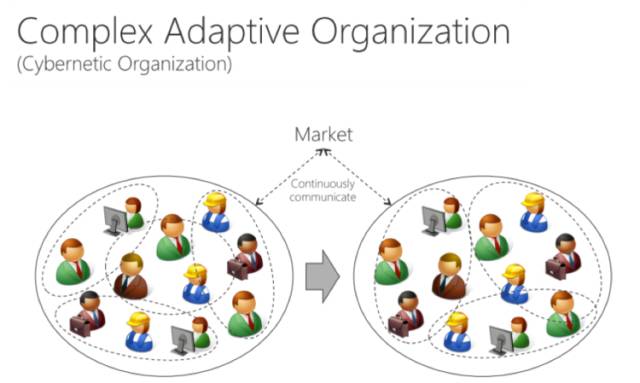
The complex adaptive organizational structure in the picture above, also known as the control feedback organizational structure (Cybernetic Organization), is currently relatively rare among established companies (only seen in a few startups), but it is a new trend in future organizational structures. This structure does not have centralized goal setting. The cross-functional mixed and collaborative team directly connects with the market, continuously communicates with the market to obtain needs, and responds quickly and flexibly to market changes.
The advantages, disadvantages and suitable scenarios of this organizational structure are as follows:

Mel Conway proposed the so-called Conway's Law [Appendix 3] in 1967, which pointed out that there is an implicit mapping relationship between organizational structure and system architecture:
Organization which design systems […] are constrained to produce designs which are copies of the communication structures of these organizations.
The design of the organization of the design system is equivalent to the communication structure between organizations
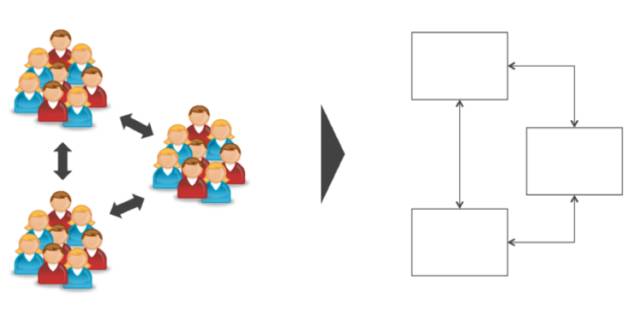
Conway's law can also be stated in reverse:
Conway’s law reversed: You won’t be able to successfully establish an efficient organization structure that is not supported by your system design(architecture).
You cannot build an efficient organizational structure if your system architecture does not support it. You can't build an efficient system architecture if your organizational structure doesn't support it.
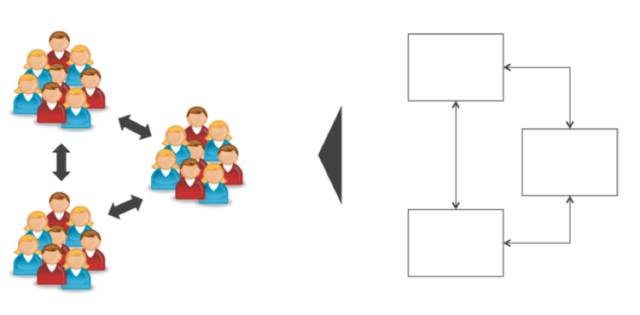
Conway's Law gives us a good inspiration. There is an implicit mapping relationship between system architecture and organizational structure. You cannot unilaterally change the structure of one side, and both sides must be linked when adjusting. As shown in the figure below, if the system architecture is monolithically coupled, it will be difficult to organize a decentralized cross-functional market-oriented team structure. The two sides cannot be mapped, and friction and fights between teams are inevitable. Therefore, we generally first decouple and split individual applications according to business line boundaries, and at the same time make corresponding organizational structural adjustments. This is the motivation behind the microservice architecture that has become popular in recent years.
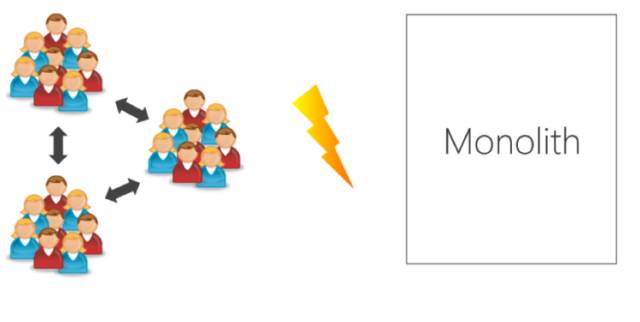
Technical architecture cannot exist and be designed unilaterally independently. It has an implicit mapping relationship with the organizational structure and supports the core driving elements of the organization. The following two figures respectively illustrate the core architecture driving elements of Taylor-type organizations and complex adaptive organizations, as well as the resulting application architecture characteristics.


From the technology stack and application architecture characteristics adopted by an organization, you can also quickly infer the organization's business model and organizational structure, as shown in the figure below. Monolithic architecture, centralized database, and layered architecture are common in Taylor-type organizations; while cloud computing, REST microservices, and DevOps technologies are common in Beta and complex adaptive organizations. The figure below also reflects the synchronous evolution trend of organizational structure and technology stack.
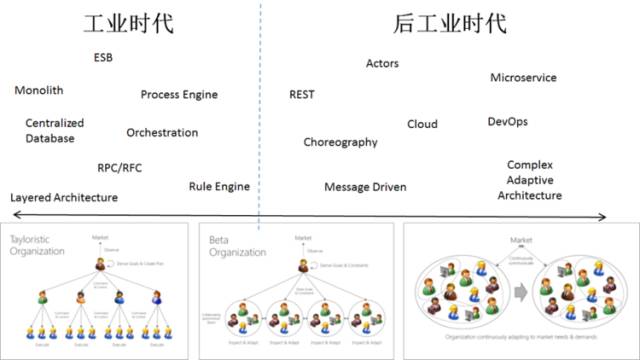
- We have entered the post-industrial era, and organizations need to adjust their structures to adapt to new market changes. Complex adaptive architecture is the evolutionary trend of future organizational architecture.
- There is an implicit mapping relationship between the market, organizational structure, system architecture and technology, which cannot be simply designed and unilaterally adjusted. Qualified architects must have insight into this mapping relationship, systematically and flexibly promote organizational and system architecture adjustments based on market and organizational status quo, align enterprise business, organization and technology, and respond to market changes more agilely.
- Without changing the enterprise's organizational structure and management culture, it is difficult to unilaterally change the enterprise's technical architecture. In the end, the technical architecture will be constrained by the strong organizational structure and enterprise management culture, reflecting the enterprise's management culture and organizational structure. (This article does not talk about corporate management culture, but corporate management culture is also crucial to corporate architecture).
- In the digital transformation of an enterprise, the adjustment of the system architecture and the enterprise's organization and management culture must be carried out simultaneously, and the key is the transformation of the enterprise's organizational and management culture structure.
The above is the detailed content of The impact of an enterprise's organizational structure on its technical architecture. For more information, please follow other related articles on the PHP Chinese website!

Hot AI Tools

Undresser.AI Undress
AI-powered app for creating realistic nude photos

AI Clothes Remover
Online AI tool for removing clothes from photos.

Undress AI Tool
Undress images for free

Clothoff.io
AI clothes remover

Video Face Swap
Swap faces in any video effortlessly with our completely free AI face swap tool!

Hot Article

Hot Tools

Notepad++7.3.1
Easy-to-use and free code editor

SublimeText3 Chinese version
Chinese version, very easy to use

Zend Studio 13.0.1
Powerful PHP integrated development environment

Dreamweaver CS6
Visual web development tools

SublimeText3 Mac version
God-level code editing software (SublimeText3)

Hot Topics
 What computer configuration is required for vscode
Apr 15, 2025 pm 09:48 PM
What computer configuration is required for vscode
Apr 15, 2025 pm 09:48 PM
VS Code system requirements: Operating system: Windows 10 and above, macOS 10.12 and above, Linux distribution processor: minimum 1.6 GHz, recommended 2.0 GHz and above memory: minimum 512 MB, recommended 4 GB and above storage space: minimum 250 MB, recommended 1 GB and above other requirements: stable network connection, Xorg/Wayland (Linux)
 Linux Architecture: Unveiling the 5 Basic Components
Apr 20, 2025 am 12:04 AM
Linux Architecture: Unveiling the 5 Basic Components
Apr 20, 2025 am 12:04 AM
The five basic components of the Linux system are: 1. Kernel, 2. System library, 3. System utilities, 4. Graphical user interface, 5. Applications. The kernel manages hardware resources, the system library provides precompiled functions, system utilities are used for system management, the GUI provides visual interaction, and applications use these components to implement functions.
 How to run java code in notepad
Apr 16, 2025 pm 07:39 PM
How to run java code in notepad
Apr 16, 2025 pm 07:39 PM
Although Notepad cannot run Java code directly, it can be achieved by using other tools: using the command line compiler (javac) to generate a bytecode file (filename.class). Use the Java interpreter (java) to interpret bytecode, execute the code, and output the result.
 vscode cannot install extension
Apr 15, 2025 pm 07:18 PM
vscode cannot install extension
Apr 15, 2025 pm 07:18 PM
The reasons for the installation of VS Code extensions may be: network instability, insufficient permissions, system compatibility issues, VS Code version is too old, antivirus software or firewall interference. By checking network connections, permissions, log files, updating VS Code, disabling security software, and restarting VS Code or computers, you can gradually troubleshoot and resolve issues.
 How to check the warehouse address of git
Apr 17, 2025 pm 01:54 PM
How to check the warehouse address of git
Apr 17, 2025 pm 01:54 PM
To view the Git repository address, perform the following steps: 1. Open the command line and navigate to the repository directory; 2. Run the "git remote -v" command; 3. View the repository name in the output and its corresponding address.
 Can vscode be used for mac
Apr 15, 2025 pm 07:36 PM
Can vscode be used for mac
Apr 15, 2025 pm 07:36 PM
VS Code is available on Mac. It has powerful extensions, Git integration, terminal and debugger, and also offers a wealth of setup options. However, for particularly large projects or highly professional development, VS Code may have performance or functional limitations.
 How to use VSCode
Apr 15, 2025 pm 11:21 PM
How to use VSCode
Apr 15, 2025 pm 11:21 PM
Visual Studio Code (VSCode) is a cross-platform, open source and free code editor developed by Microsoft. It is known for its lightweight, scalability and support for a wide range of programming languages. To install VSCode, please visit the official website to download and run the installer. When using VSCode, you can create new projects, edit code, debug code, navigate projects, expand VSCode, and manage settings. VSCode is available for Windows, macOS, and Linux, supports multiple programming languages and provides various extensions through Marketplace. Its advantages include lightweight, scalability, extensive language support, rich features and version
 vscode terminal usage tutorial
Apr 15, 2025 pm 10:09 PM
vscode terminal usage tutorial
Apr 15, 2025 pm 10:09 PM
vscode built-in terminal is a development tool that allows running commands and scripts within the editor to simplify the development process. How to use vscode terminal: Open the terminal with the shortcut key (Ctrl/Cmd). Enter a command or run the script. Use hotkeys (such as Ctrl L to clear the terminal). Change the working directory (such as the cd command). Advanced features include debug mode, automatic code snippet completion, and interactive command history.





